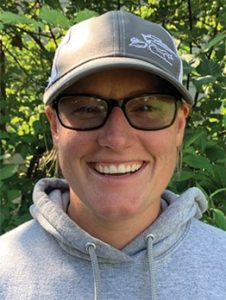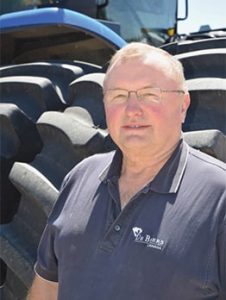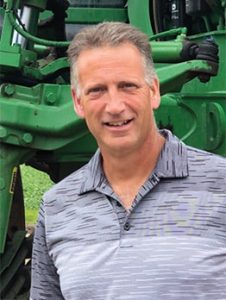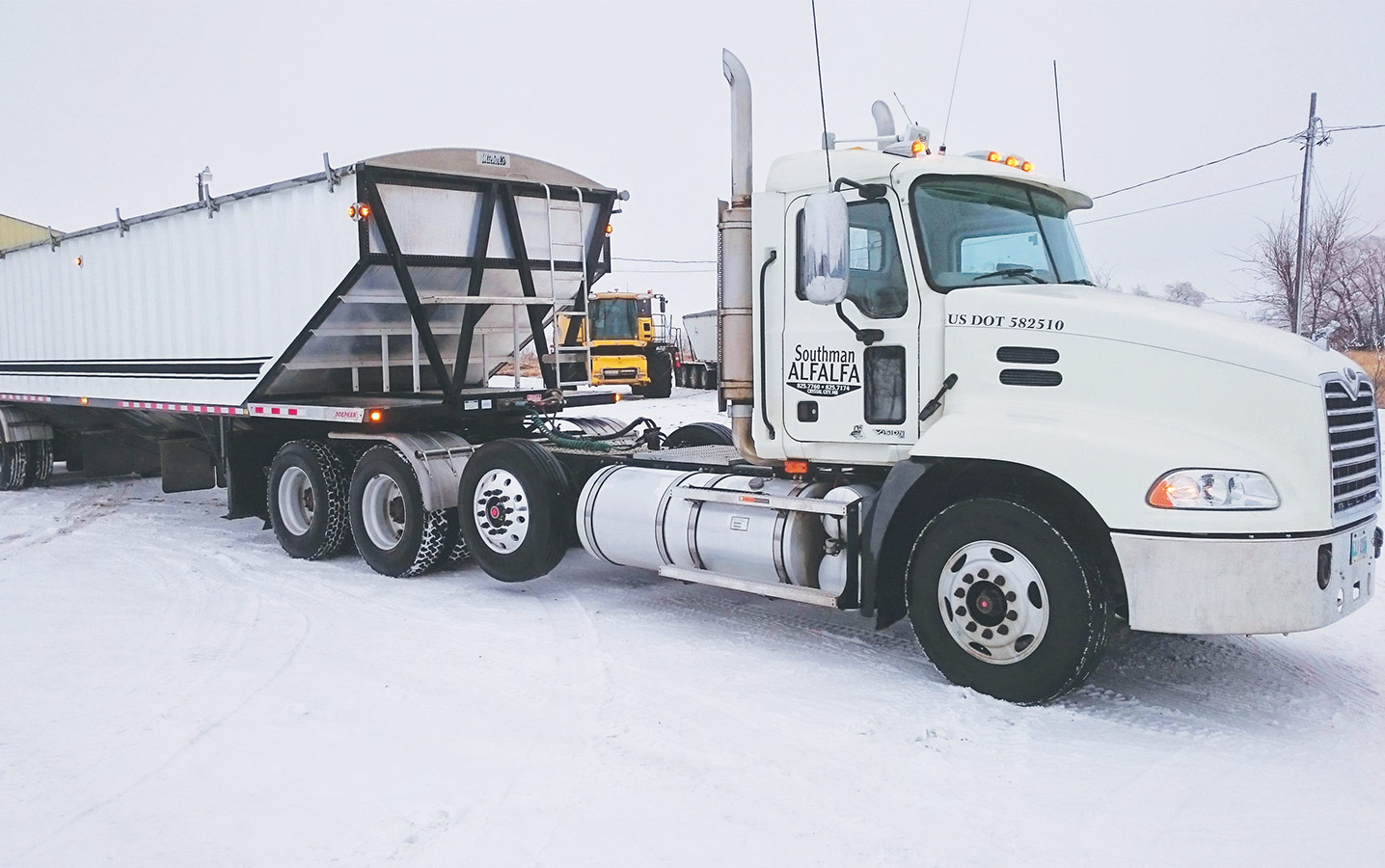Trucking Grain: DIY or custom all the way?
Anthony Eliason
Outlook, Sask.
Anthony Eliason has custom truckers move most of his grain. “It’s easier to have them handle the registration and licensing. That way we can have cheaper, older semis for our own use, and we only have them plated for when we need them,” he says.
“Another advantage is that I don’t have to sit in lineups. This frees me up to do lots of other things during the day. You can waste a whole morning in a lineup.” Lineups are often more common for farmers who do their own trucking. “Crushers have dispatchers to arrange on-farm pick up and schedule unloads at the facility. When you deliver yourself, you have to book your own openings and sometimes have to wait all day to unload.”
Anthony Eliason has custom truckers move most of his grain. “It’s easier to have them handle the registration and licensing. That way we can have cheaper, older semis for our own use, and we only have them plated for when we need them.”
With custom trucking, Eliason can move grain when he’s busy in the field. “That flexibility sometimes means price premiums when delivering in May or September-October when people are too busy to deliver.”
Finally, hiring custom operators means he doesn’t have to worry about breaking down.
“I know some who have had to pay a couple-hundred dollars to get a big truck towed. I don’t need that.”
Eliason’s primary delivery locations are at Clavet, Saskatoon, Rosetown and Davidson. “Each is about an hour away by truck, which makes it easier to shop for best prices,” he says.
He compares custom truckers to find the best rate. “Most are really good and they make up for those few drivers and dispatchers who are not,” he says. “I’m surprised some of them still have a job. I’ve had many lost drivers who were given GPS coordinates. I’ve had drivers drive over swaths. And I’ve had dispatchers cancel or postpone loads but not call to update us.”
He expects new driver training regulations in Saskatchewan may shift more trucking to custom. “I took a one-week training course to get my Class 1A license when I was 19. There was good value in doing that, so the new regulations have merit,” he says, “but the on-the-job training requirement will be difficult for most farmers to achieve. They will have to work off the farm to get enough hours.”
 Brooke Parker
Brooke Parker
Strathmore, Alta.
Brooke Parker goes above and beyond farm truck requirements by having all the farm trucks certified through the Commercial Vehicle Inspection Program (CVIP). “This is a cost to us and is not required for farm trucks in Alberta, but we think it’s important to make sure our trucks are safe.”
Four years ago Brooke Parker wanted to move a truck from one yard to another just a few miles away. It was a quick job, but all the farm’s Class 1 truckers were tied up. That was the moment she realized she should get her Class 1. So she did.
The farm, Risdon Farming Ltd., now has four Class 1 drivers and does a significant amount of its own trucking with two Super-Bs and one tri-axle. They also maintain relationships with custom carriers to help at harvest or as otherwise needed.
“Having our own trucks gives our operation flexibility to move the drivers between truck driving and equipment operation,” Parker says. “Challenges or frustrations with doing our own trucking is lineups at the elevators and untimely breakdowns.” Otherwise their trucking operations work smoothly, she says.
Parker goes above and beyond farm truck requirements by having all the farm trucks certified through the Commercial Vehicle Inspection Program (CVIP). “This is a cost to us and is not required for farm trucks in Alberta,” Parker says, “but we think it’s important to make sure our trucks are safe.”
 Landon Friesen
Landon Friesen
Crystal City, Man.
“I’ve always liked to do things on our own…. And if you’re going through all the steps yourself to set up for delivery to the States, then you might as well truck it all yourself.”
Landon Friesen farms just north of the North Dakota border and trucks a lot of grain into the U.S. This presents a few challenges. Purple farm fuel is not allowed in North Dakota. He needs U.S. Department of Transport permits for all trucks going across the border on a regular basis. Weight restrictions are also different. Generally, weights per axle are lower in North Dakota, so he can’t fill trucks as full when heading south. As a work around, he added a ‘pusher axle’ to one truck. The two extra wheels just in front of the drive axles allow him to carry 10,000 extra pounds in North Dakota. These axles are not approved for Manitoba, so he lifts them until he gets to the border.
Another issue with cross-border delivery is that the closest ports now have limited hours. “Customs itself has been excellent for us,” Friesen says, “but our nearby ports are often only open from 11 a.m. to 7 p.m.” 24-hour ports are one hour away at Boissevain or two hours away at Emerson. “Delivering through the local ports means we can usually only do one or two loads a day.”
In the end, the expanded market opportunities they gain from farming so close to the U.S. are worth the extra time and cost of permits and border crossing.
The farm has four trucks and they do 90 per cent of their own trucking. “I’ve always liked to do things on our own. We can control when the trucks come and go,” Friesen says. “And if you’re going through all the steps yourself to set up for delivery to the States, then you might as well truck it all yourself.”
“The roads down south are better, too,” he adds.
 Keith Fournier
Keith Fournier
Lone Rock, Sask.
“Because we can now drive in our yard at any time of year, we can pick up a few premiums here and there in those more challenging months to help pay for the cost of the bin yard.”
Keith Fournier decided to perform major surgery on his yard to improve his trucking and marketing. The motivator was a number of situations where the elevator would call for delivery but the yard was just too soft to support the trucks. “We had to refuse because we knew the trucks would just leave ruts and make a big mess of the yard,” he says.
At one point, he decided that the lost opportunities were getting too costly. So he rebuilt the yard. He stripped away all the top soil and added six inches of crushed rock for a base. “Now we’re set up for 365 days of hauling,” he says. “Even when the yard is wet and soft in March and April, we can still move grain.”
It has been good for business and for customer relations. “It doesn’t matter what the trucking conditions are like, feedlots still need barley and crushers need canola,” Fournier says. “Because we can now drive in our yard at any time of year, we can pick up a few premiums here and there in those more challenging months to help pay for the cost of the bin yard.”
The farm does most of its own hauling. “Two years ago, my nephew came back to the farm and we got him to get his Class 1 license,” Fournier says. “He drives the truck for us. The only time he can’t haul grain is when the truck is tied up to handle seed in the spring or run grain back to the bins during harvest. “When we’re busy, we won’t hesitate to bring in a custom trucker.”
 John Sandborn
John Sandborn
Benito, Man.
John Sandborn’s grain hauling has evolved over the years. “Back when we had elevators close by, we’d haul ourselves. Then when the local elevators closed, we used mostly commercial trucks to transport the longer distances. Now I have a tri-axle trailer and my Class 1 license, so I haul my own grain again.”
The ideal custom trucker, says John Sandborn, is one who knows your yard and will look after loading themselves. “That way, if they don’t get to your place when they planned, I don’t have to wait. I just set things up for them and they look after the rest.”
The Swan River Valley has only one elevator and it’s at the opposite end of the valley from Sandborn’s farm. So he ends up delivering most of his canola south to the processing plants at Yorkton (Richardson and Louis Dreyfus) or Harrowby (Bunge). Sandborn likes that the processors can give him a specific delivery time slot and he says they’re usually pretty good at keeping on schedule.
He also likes the flexibility of hauling his own grain. “Truckers don’t usually like waiting around if I have to clean up the bin bottoms. With my own truck, I can load up from the bin bottoms on my own time,” he says. “Another advantage is that I can haul off the combine. I can load the truck in the evening, then leave at 4 o’clock in the morning and be back before the fields are ready to harvest again.”
Disadvantages of hauling his own grain are navigating the big valleys in the area. He likes routes without any intersections that require him to yield the right-of-way. He also tries to limit trucking in winter so he doesn’t have to drive around the icy corners at the bottom of steep river valleys and so he can avoid loading in the cold. Salt used in the winter is really hard on trucks and trailers, he adds. “You don’t want to leave it or corrosion kicks in, but it can be hard to wash the trucks at -30°C. In that situation, I have to use heaters to thaw things out so the brakes work.”
While Sandborn will use custom haulers from time to time, he says it can be hard to find one on short notice. “They have to keep their trucks rolling and are usually booked up for a week or two in advance.”
The ideal custom trucker, Sandborn says, is one who knows your yard and will look after loading themselves. “That way, if they don’t get to your place when they planned, I don’t have to wait,” he says. “I just set things up for them and they look after the rest.”
 Roger Chevraux
Roger Chevraux
Killam, Alta.
“I now have full-time people working for me, so one way I can justify keeping them on all year is to put them on our own trucks.”
Roger Chevraux used a lot of custom truckers when he worked off the farm. Whenever he booked a sale and arranged for on-farm pick up, he would ask for two or three days notice so he could have everything set up. He wasn’t able to get back to the farm while he was away working, so things had to be organized in advance. “But the trucker would often call en route and tell me he’d be there in an hour,” he says. “It was a common frustration. I wasn’t around so I would have to ask a neighbour to get the bin and auger ready.”
Now that Chevraux is back to farming full time, he does most of his own trucking. At harvest, he uses two tandem trucks, basically as high-speed grain carts, to move grain from the combine to the bin. “We have five bin-yards around the farm and the farthest distance from field to bin is about two miles,” he says. For transportation to elevators or processors, he has a tri-axle semi.
Do you have feedback on the farmer panel? Do you want to participate in a future farmer panel? If yes, please email the editor, Jay Whetter, at whetterj@canolacouncil.org
“I now have full-time people working for me, so one way I can justify keeping them on all year is to put them on our own trucks,” Chevraux says.
Custom truckers still do some of the long-distance deliveries. Chevraux wishes all custom truckers were as reliable as a local trucker he prefers to hire. That trucker brings everything he needs, including a drag auger for the bin bottoms. “He almost likes it better when I’m not there,” Chevraux says. But he can’t use the local trucker for a lot of the long-distance deliveries, especially to feedlots in southern Alberta, because the feed-sales brokers have pre-arranged contracts with their own truckers.






